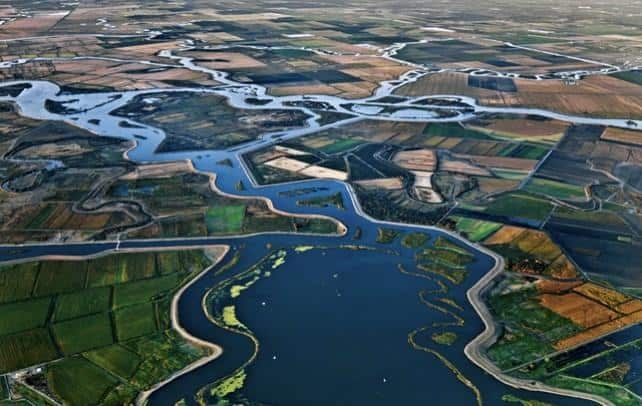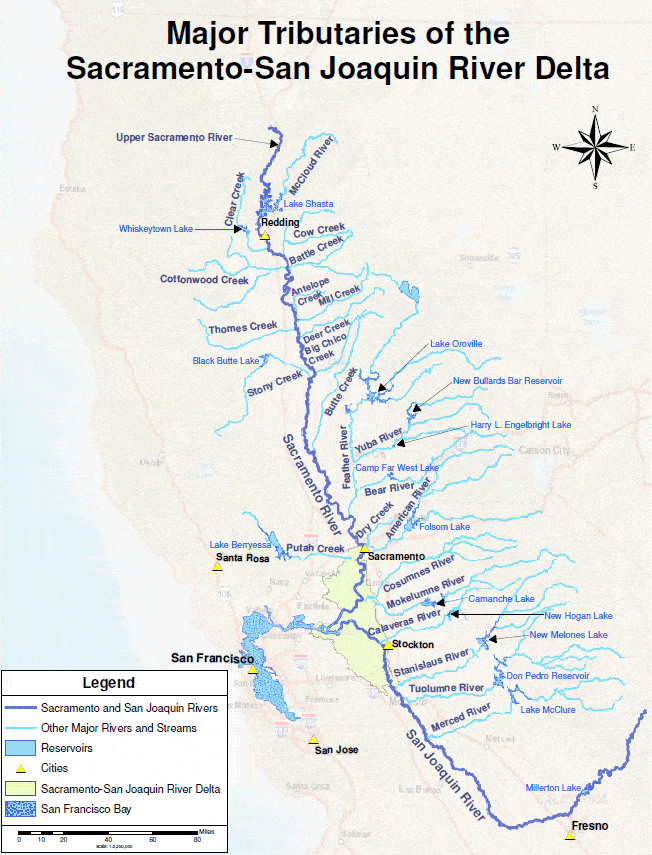CCWD Opposed to Unimpaired Flow Approach of Bay-Delta Water Plan Update - August 31, 2018
Those who follow the news are sure to have seen headlines regarding the proposed amendments to the Bay-Delta Plan (Plan). The Plan is divided into four distinct phases, and Phase I involves the Lower San Joaquin River, which includes the lower Stanislaus, Tuolumne and Merced Rivers. The Stanislaus River and its reservoirs are the municipal and agricultural water supplies for the Highway 4 corridor of Calaveras county.

The San Francisco Bay Delta viewed from above. Image courtesy of the Tuolumne River Trust.
The final draft amendments to the Plan being considered by the State Water Resources Control Board (State Board) call for a dramatic increase in the amount of water that flows out of the Lower San Joaquin River between February and June to help endangered species and improve water quality.
A large coalition of agricultural and municipal water stakeholders throughout the state, including CCWD, believe this flow-centric approach misses the mark in oversimplifying a very complex issue to the potential detriment of the environment and the state’s water supply.Dave Eggerton, CCWD General Manager
The difference of opinion between the State Board and regional stakeholders led to a protest at the State Capitol August 20 and numerous threats of litigation. The State Board had planned to vote on the proposal in mid-August, but significant opposition to the draft Plan caused the vote to be postponed until November 7.

Image courtesy of Maven’s Notebook.
Phase I of the draft Plan outlines proposed changes to the management of water flowing through the lower San Joaquin River, which converges with the Sacramento River in the Delta and meets incoming seawater from the Pacific Ocean in the San Francisco Bay (more info here). From February through June of each year, the draft Plan would require the “unimpaired flow” of 30-to-50% of all water in the San Joaquin River and the lower reaches of its tributaries through the Delta, which could not be diverted to storage for agricultural, municipal or any other use. In an attempt to recreate more “natural flow” conditions of an earlier time, far less water would be available for impoundment in local reservoirs. According to the draft Plan this approach is necessary to help salmon populations recover in the San Joaquin River Basin that have plummeted from 70,000 in the mid-1980s to 10,000 in 2017 as well as improve the overall Delta ecosystem and water quality.
Fact Sheethttps://www.youtube.com/watch?v=x3FAmiVGiAQ
Yet water agencies, agriculturists, municipalities and other stakeholders across the state firmly believe this singular focus on unimpaired flows fails to address the multitude of other stressors on the Delta’s fishery and ecosystem that threaten salmon’s survival such as predation, loss of habitat, and the timing and function of water flowing through the system. At the same time, by reducing access to stored water, the draft Plan unnecessarily threatens the reliability of municipal and agricultural water supplies, hydropower production, local jobs and economies, and the ability to recover over-drafted groundwater basins such as the Eastern San Joaquin.
For these reasons, CCWD has continued to work to influence the outcome of this critically important regulatory process through written testimony to the State Water Board both individually and collectively with other agencies (See CCWD’s letter submitted on July 27, 2018, here). With a final decision on Phase I still to come and other equally important phases to follow (affecting the Calaveras and Mokelumne Rivers), CCWD will continue to advocate for the interests of our community throughout this process before the State Board. In addition to promoting comprehensive solutions that more appropriately address the complexities of the challenges in the Delta than the flawed approach reflected in the draft Plan, the District will continue to encourage the State Board to focus on reaching voluntarily negotiated agreements with affected water rights holders that meet the needs of municipalities, agriculture and the environment.
CCWD-Comment-Letter-BDCP-PH1-Amendments.pdfCCWD is also a signatory to coalition letters
- Association of California Water Agencies (ACWA) (see letter here)
- San Joaquin Groundwater Sustainability Agencies (see letter here)
CCWD is currently coordinating with other regional partners, state agencies, and stakeholders pursuant to the Governor’s “Principles for Voluntary Agreements” for Phase II of the Bay-Delta Plan Update, which includes the Calaveras and Mokelumne Rivers. More information will be provided as it becomes available.
